Executive Summary
Engineering for community development is a project work that is designed for Shaima village. It is a project that is to be carried out by the Stepping Forward Engineering Group. It clearly shows how the group intends to provide the village with power, water and road transport. The provision of all these services will ensure utilization of local resources and employment of the local people. If this project is implemented, it will definitely improve the standards of living and the thinking of the villagers in question. It is on this basis and on the description of the entire project provided here that this projected ought to be considered for funding.
Introduction
A successful piece of work calls for both preparation and planning. The Stepping Forward Engineering Group has done a lot in relation to this in coming up with this project. The report describes the blueprint of the engineering work within Shaima village. The village is found in Saudi Arabia’s Empty Quarter Desert. What will be provided through this project include road transport, water and power. The first part of the report provides some facts and information regarding the Shaima village. The next part is about provision of power to the village. It describes how renewable power sources: wind and solar energy will be harnessed in Shaima village and serve approximately one hundred families in the village. The next parts are a description of how the group will provide water and road transport to Shaima village. The last four sections are table of the estimated project cost, the group’s vision, conclusion and recommendations of the project report. The rationale behind the entire engineering project was birthed by a team of engineers who asserted that energy sources can be linked through the medium of electricity and help us accomplish our desires which may entail performing work, satisfying a want or meeting a certain need (Toepfer, 2010, p.7). Providing the villagers with a stable source of electric power will really help them to transform their lives after struggling to stay alive in a very unforgiving landscape.
Village Profile
It is in Saudi Arabia’s Empty Quarter Desert that the Shaima village is found. The distance between it and the electrical grid is too long. It is an arid region and quite disconnected from the nearby urban centers. The village has approximately 100 families with a population of about 700 individuals. A description was made by team of geographical explorers regarding engineers that may wish to extend their assistance to the residents of Shaima village and their sentiments were that
“For thousands of years this territory has resisted settlement as one of the Earth’s hottest, driest, and most unyielding environments… at more than 583,000 square miles, it takes in substantial portions of Saudi Arabia, as well as parts of Oman, Yemen, and the United Arab Emirates” (Webster, 2011, p.1).
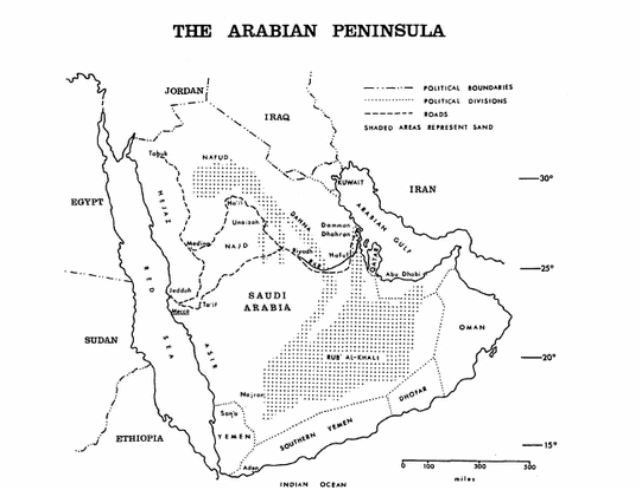
Project Preparation
To ensure success in the project, it was first and foremost important to carry out data collection. To facilitate this, a trip to Shaima should be conducted. This trip was meant to access the feasibility of conducting the project, to carry out background study of the recent technology, to meet with the relevant persons and institutions, and to select the right people.
The latest challenges in the project include funding of the project, accessing the site, conducting the drilling activities and finding qualified workers. To get over some of these challenges, the SFEG should partner with a number of stakeholders. In coming up with competent workers, technical training should be offered. For purposes of efficiency, the trainees should be provided with training material.
Therefore, to be able accomplish the requirements of this project, funding has to be provided. The SFEG groups anticipates that the project should be funded by the World Bank and the local government. It is expected that based on the aims of the project in reducing poverty by providing job opportunities to the Shaima villagers and improving their lives and way of thinking through provision of power, water and road transport, the government should consider funding it.
Power
For a long time, man has been depending on fossil fuel as the best source of energy. At some point, it was affordable and in plenty. It contributed to the devising of other forms of technology. Most importantly, regions that did not have natural resources but had the potential to produce geothermal power were provided with electricity. Nonetheless, in the last few decades, the cost of fossil fuel has been on the rise. Additionally, studies have indicated both carbon dioxide and the by-products of refining fossil fuel have greatly contributed to global warming (Uzawa, 2003, p. 11).
It is thus vital to devise another source of energy. For the case of the residents of Shaima village, the new source of energy is supposed to be not only cheap, but also clean. Solar and wind systems of energy are ideal for desert regions such as the Empty Quarter Desert due to the dominance of windy and sunny conditions in these places (Allaby & Garratt, 2006, p. 162). A wind turbine operating on a small scale can be installed and be used to power a small generator. The power can then be collected by a battery that will be recharged every day. Similarly, the solar panels will be able to collect energy and transform it into electric energy (Rosser, 2008, p. 140; Walker & Wood, 2009, p. 30).
The hybrid system is another solution with great potential. Experts in this field suggest that, “hybrid energy is an integration of renewable resources such as the solar, wind turbines, biomass, geothermal and the micro-hydro energy with the fossil fuel powered generators” (Gupta & Sharma, 2008, p.1). In this configuration, a “hybrid energy systems consist of at least two energy systems one of it is the fossil fuel system that guarantees the stability of the power production” (Gupta & Sharma, 2008, p.1). This idea is an excellent one especially when looking at the goal of providing a stable source of energy. However, considering the remoteness of Shaima village and the poor transport network in the region, coming up with an option that is easy to maintain will be better. To attain this end, an integration of solar panel and a wind power generator into a hybrid system is the best option for Shaima village.
Any region within the world, with its natural resources can utilize this option. Since the Empty Quarter Desert is abundant in wind and sun, the best form of energy for the region would be wind power, solar power or a combination of both.
Coming up with a plan that will be beneficial to both households and the commercial enterprise is crucial. However, both the harsh environment and the location of the village are to be put into perspective. This will be helpful in developing a plan that has a high potential of success and one that is easy to implement. It will also encourage the villagers to adopt, embrace and maintain the new way of life. In this respect, two vital steps are to be taken. They include resources assessment and demand assessment.
There are two main stages for the electrification of Shaima village. The first stage entails the main power resource for public services and enterprises. On the other hand, the second stage is for the separate powering units for the households. In stage one; we have wind turbines in series and a solar plant. These are provided by the general electric energy as illustrated below.
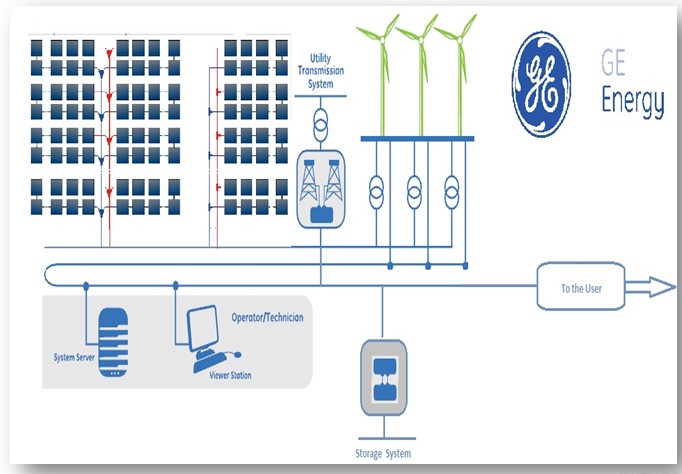
The main source of power in stage 1 is the solar panels and wind turbines. These two sources of energy are converted into electrical energy through a utility transmission system. The utility transmission system comprises of a system server, viewer station and storage system. From the wind turbines and the solar panels, power flows to the system server and then to the viewer station. The viewer station should have an operator to monitor and regulate the power flow. From the viewer station, it flows to a storage system where it is connected to different services and public enterprises for use. These include lighting street bulbs and powering the brick oven.
On the other hand, stage two comprises of a hybrid solar – wind generator system. The energy is generated from the integration of the wind and the solar panel. The electrical energy from this hybrid system passes through a charge controller and is then stored in a battery bank. From here, it flows to an inverter where it is converted from AC to DC form. From the inverter, it can now be used in the households.
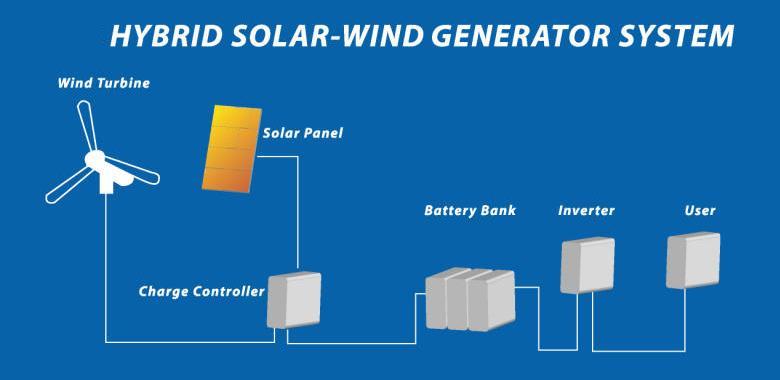
The power generated by this system is about 150 KW which is sufficient for various household tasks such as lighting the house, running the refrigerator and operating both entertainment and communication devices.
The location of Shaima is the desert part of Saudi Arabia. It is very remote from the nearby town. In fact, the residents of Rub al Khali do not have electricity. The power plant that can be said to be close to the village if 900 km away from it. It is not possible to connect to the electrical grid since there is no means of doing so. Also, it would be expensive to purchase fuel and transport it to this region. Although there are other suggestions such as relocating the village residents to town that has electric power, this may not work due to the reluctance of the villagers.
Anthropologists that work in this region have revealed that the culture and life style of the Shaima people borders on nomadism. While referring to the residents within the Empty Quarter Desert, the anthropologists remark that there are some people who are in the desert’s interior, distant from centers of agriculture and they rarely interact with agriculturalists. It’s suggested that most of them are conventionally accustomed to camel rearing (Cole, 2010, p. 23). This shows the villagers’ contentment in dwelling n the desert and may not be ready to depart from it.
Shaima village stands a chance to be considered because its remoteness from the electric power plant. Moreover, its residents find it difficult in struggling to survive within the desert. Providing the villagers will renewable form of power will help to facilitate refrigeration of various products. It will also enable them to make use of other devices that can add value to their lives. Examples of such devices include computers and communication gadgets.
Thus, each family ought to be accessible to wind-solar form of energy that can help them operate a personal computer, a radio and a refrigerator. Through use of the computer, the villagers will increase in learning by gaining computer skills. On the other hand, they will be kept informed through use of radios. The climate and environment of the place make it suitable for the project to be implemented in the region. Theirs is a sunny form of weather with temperatures above 50 degree centigrade during summer. The rise in temperature during daytime and its drop in the evenings facilitates movement of air. This can generate wind that can rotate a small wind turbine and generate power in the evening.
The managers in charge of the project came to realize that an appropriate type of solar panel is sold by a certain company. The name of the product is 80W Solar Energy System with Xantrex (SolarHome, 2011, p.1). From the perspective of the manufacturers, “The Xantrex system has been designed to operate a road variety of appliances including a microwave oven, computer, refrigerator-standard size and coffee pot (SolarHome, 2011, p.1).
Transport
Transport network for Shaima village will be done by manufacturing road bricks. Given the remoteness of the village, the team thinks that it is necessary to improve road transport network within it. Therefore, the main concern is how the team can lead to an improvement in the sandy, rocky and uneven road surface. The SFEG discovered that the best way to construct these roads is by using readily available materials. Bricks to be used in road construction can be manufactured and baked using the new power sources described above.
There’re several reasons for the use of bricks in building the roads. First, the bricks are durable. This does not only suit the quiet life in the village, but also adds aesthetic value to the landscape in the village. Second, the bricks are inexpensive. This is because they’re to be built from the available sand from the village. Besides, renewable sources of energy such as solar energy will be helpful in baking the bricks.
Third, employment will be created. Bricks will be made by compressing the sand and laying the bricks tightly at the top. This will create jobs for the locals. Moreover, maintaining of the roads is easy and environmental friendly. This can be done by recycling the damaged bricks from the same road.
Road construction will entail several steps. First, the sand will be collected and transported to the bricks factory which is powered by the solar panel. While here, sand will be mixed with water for shaping into bricks. The final step will be baking the bricks (MadeHow, 2011). After production of bricks, road construction will commence. At the same time, the village streets will be lit using solar street lighting energy – bulbs. These bulbs are flexible and inexpensive to maintain. They will be powered by the solar panel.
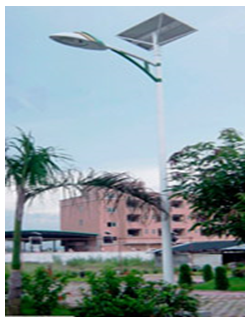
Water
This being a village in an arid area, the need for a reliable source of water is critical. They need water for daily life purposes such as drinking, washing and cooking. It is therefore important for the SFEG to devise a strategy of helping this village to get over the problem of water scarcity. The village Shaima is located about 80 kilometers from its nearest water resource which make it difficult for villagers to provide it with enough water for everyday use and villagers cannot go to that water resource during night time. The viable option that the group came up with is the use of ground water.
The group devised four processes that should be used in the generation of this ground water. First, we have the location process. The group should carry out a survey in the entire Shaima village to locate a suitable site from where ground water can be generated. The location should be close to a source of power that can be used to pump water. After locating a suitable place, the second process is drilling. Wells should be drilled in the located region up to great depths of underground water. The drilling process requires the use of rigs which can drill deep.
Thirdly, we have the process of pumping. After drilling the wells, the SFEG will use thin pipes and power to pump the water. Thin pipes will be used to distribute the water to all households and other important regions. Fourth, we have the water storage process. There will be storage tanks with pipes connecting them with the electric pumps. The storage tanks will be kept in a place that is insulated and one that can act as a cold room. In this insulated area, water will be kept at low temperatures especially during summer time. This room can be utilized for other purposes such as storage of vegetables.
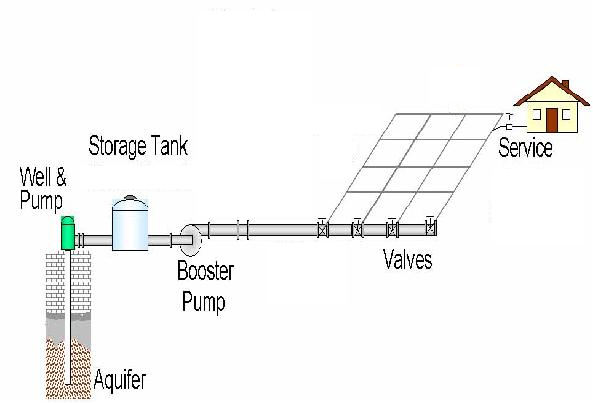
After drilling the wells, ground water is extracted from an aquifer and pumped and transported by pipes into the storage tank. From the storage tank, it is connected by some other pipes to a booster pump. The booster pump has an extending pipe with several valves. The water thus flows from the booster pump through the valves and other pipes that connect it to the households where it is used.
Summary of Estimated Project Cost (in $)
SFEG’s Vision
The group’s vision is to lead to a lasting transformation in the way of life of the Shaima village residents. This is to be done through the provision of water, power and road transport to the villagers. It is also envisioned that their mentality will be changed and help to boost their self esteem and value just like other people in urban places.
Conclusion
This project is the brainchild of the Stepping Forward Engineering Group (SFEG). It is aimed at transforming the way of life in Shaima village by providing the village residents with power, water and road transport. Power is to be provided through natural renewable sources of energy – wind and solar energy. This is because these sources are environmental friendly and readily available. Power is generated both for enterprise use and household consumption. Water is drilled from underground wells and pumped to various households for diverse uses. Village roads are to be constructed using bricks. The bricks are to be made from the available sand and be baked using available solar power through solar panels. Use of bricks will lead to durable, easy to maintain and environmental friendly roads. In the processes of providing power, water and road transport, the local people will be employed hence helping in poverty alleviation from the village.
Recommendations
The group recommends that with regard to power, some technicians from the village should be trained to for operation and maintenance purposes. Also, in future, an income generating industry and one that will utilize the available power can be established. This will not only improve Shaima’s economic status, but will also lead to better utilization of power. Second, with regard to the provision of water, in future, water should be treated for maintaining of quality and for the health safety of the village residents. This is because ground water contains several mineral salts and not all of them may be beneficial to the human health (Cech, 2009, p. 150). Also, solar water heaters should be introduced to help the villagers who may want to heat water for various purposes. Third, on transport, there should be introduction of safety measures to prevent accidents. In general, agriculture can be integrated to help in the utilization of available water and for boosting of the local economy. Moreover, educational services should be established in the village to help train the residents in maintaining and improving the resources.
Reference list
Allaby, M. & Garratt, R., 2006. Deserts. NY: Infobase Publishing.
Cech, T.V., 2009. Principles of water resources: history, development, management, and policy. Hoboken, NJ: John Wiley & Sons.
Cole, D. 2010. Bedouins of the Empty Quarter. Aldine Transaction: New Jersey.
Cyberian Frontier., 2011. Drilling Our Fresh Water Well. By Example. Web.
Echo Solar Lighting, 2009. Street Lighting: Energy Saving Bulb Solar Street Lights. Web.
Gupta, A., Saini, R.P. & Sharma, M.P. 2008, ‘Hybrid Energy System for Remote Area – An Action Plan for Cost Effective Power Generation’, Industrial and Information Systems, 2008. ICIIS 2008. IEEE Region 10 and the Third international Conference on, pp. 1-6.
MadeHow, 2011. How Products are made: Brick. MadeHow. Web.
Rosser, S., 2008. The A-Z of Global Warming. Schmall World Publishing: Cardiff.
SolarHome. (2011) 80W Solar Energy System with Xantrex 1500. SolarHome. Web.
Toepfer, C.R. 2010. The Hybrid Electric Home, Schiffer, Atglen, PA, pp. 1-10.
Uzawa, H. (2003). Economic Theory and Global Warming. Cambridge, UK: Cambridge University Press.
Webster, D. (2005) Empty Quarter: Exploring Arabia’s Legendary Sea of Sand, National Geographic. Web.
Walker, P. & Wood, E., 2009. Space and Astronomy Experiments. NY: Infobase Publishing.
